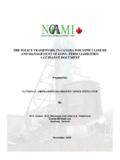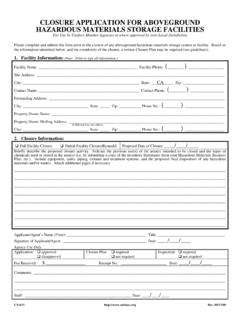Transcription of AN EXPLANATION FOR 4-WAY CLOSURE OF THRUST-FOLD …
1 AN EXPLANATION FOR " 4-WAY CLOSURE " OF THRUST-FOLD STRUCTURES INTHE ROCKY MOUNTAINS, AND implications FOR similar STRUCTURESELSEWHERE S. Parker Gay, Geophysics, South 400 EastSalt Lake City, Utah 84111 August 18, 1999 AbstractStructural systems in the Rocky Mountains comprised of end-to-endasymmetric (compressional) anticlines have been prolific producers of oil and gassince the early years of this century. Current geological thinking is that these systemsconform to the " THRUST-FOLD " (listric thrust) model of Stone (1984, 1993), a scenariosupported by numerous seismic profiles and well-sections throughout the RockyMountain province.
2 However, the THRUST-FOLD model explains the structural CLOSURE ( folding) only in the thrust direction, which is generally the short axis of thestructure. In this paper I conclude that the CLOSURE , or plunge, at the ends of theanticlines, the "longitudinal CLOSURE along the long axis, is a result of strike-slipmovement that accompanied the thrusting. I base this conclusion on the fact thatthere is shortening in the longitudinal direction, proven by the longitudinal foldingitself. This conclusion is also supported by the finding that many of the thrusts arerooted in pre-existing basement faults, which occur at angles not alwaysperpendicular to regional stress, a situation that, kinematically, requires a strike-slipcomponent of movement.
3 The resulting stress, relative to the pre-existing structure ,may be termed "transpressive."-2-IntroductionOur understanding of the structural geology of the Rocky Mountains has undergone aprofound metamorphosis in the last few decades, with most of the major advances being made in the1980's and 1990's. In the 1950's, I was taught in a petroleum geology course in Massachusetts that,since the city of Denver was at a one mile elevation and Mt. Evans was at nearly 3 miles, there wasobviously a normal fault between the two. The 1944 and 1962 AAPG Tectonic Maps of the UnitedStates(Longwall, Cohee) and the 1968 USGS Basement Rock Map of the (Bayley andMuehlberger) all showed the Front Range to be raised by normal faults.
4 Only more recently (Jacoband Albertus, 1985) was it proven by seismic data that an enormous thrust fault, or series of suchfaults, created the uplift of the Front Range. Many previous workers dating back to the 1950's hadrealized the thrusted nature of the Front Range from geological mapping - see Jacob, 1983, p. 229,for a summary of this work - but the subject was still considered controversial. A similar situation has existed in our understanding of oil field-sized structures andanticlines. Until the 1960's many people assumed that "block uplifts", near-vertical reverse ornormal faults, created the observed structural folds in overlying strata, as well as raising themountain ranges.
5 In the 1960's and 1970's the "fold-thrust uplift" model of R. Berg (1962) becamepopular, but even this rendition showed the thrust fault steepening downward into basement, makingit just a modified form of block uplift. In 1981 and 1983, Gries, using deep well information,proprietary seismic data, and published examples showed the prevalence of shallow-dipping, non-vertical thrusts throughout the Rocky Mountain province, and in 1983 and 1984 a realistic, restorablemodel that complies with this evidence was published by Stone. This model, involving a listricthrust rooted in basement, is now referred to (Stone, 1993) as " THRUST-FOLD " (see Figure 1) and is -3-proven by seismic profiles and by oil and gas well drilling of a multitude of Rocky Mountainstructures.
6 An illustration of an actual " THRUST-FOLD " structure , based on a high-quality seismic line,is that shown by Ray and Keefer (1985) for the prolific gas-producing Madden Anticline (>1 tcf) inthe Wind River Basin of Wyoming (Figure 2). The Madden structure lies in front of, and is parallelto, the far-traveled South Owl Creek, or Casper Arch, thrust and is considered an auxiliary or sympathetic thrust to this major Rocky Mountain summaries of the long history of structural geological concepts in the Rockies may behad by reading Berg (1962), Harding & Lowell (1983), and Stone (1984, 1993), and will not bediscussed further here.
7 An excellent, more general discussion of the evolution of thought on thrustedstructures worldwide beginning in the last century is found in Perry, Roeder, and Lageson (1984).-4-Explaining 4-WAY ClosureHowever illustrative and realistic the " THRUST-FOLD " model is for explaining Rocky Mountainstructure, in my opinion this model only tells half the story, structurally. It explains what I call thetransverse CLOSURE on an anticline, as shown in the usual transverse cross-section, ( , Figures 1 &2), but explorationists well know that oil and gas producing structures require 4-WAY CLOSURE in mostcases.
8 In our emphasis on studying, understanding, and balancing transverse cross-sections, we, asexplorationists and structural geologists, have generally neglected to consider the CLOSURE , or plunge,in the longitudinal direction (see Figure 3). What causes this longitudinal CLOSURE , , the plunge-5-at the ends of an anticline? This is a question seldom addressed in structural geology textbooks andthe prolific technical literature of petroleum geology. The answer I propose is quite simple, eventrivial some will say, but in my opinion it is an important advancement in our understanding ofstructural geology in compressional systems.
9 It takes us one step closer to a more comprehensiveunderstanding of regional structure in the Rocky Mountain province in general. Longitudinal closureis due to compression ( shortening ) in a longitudinal sense, that is, a stress that results in strike-slip movement along the horizontal trace of the thrust (see Figure 4). Some would describe thecausative force in this case as transpressive stress. (Transpression is a relatively new term not foundin the 1957 Glossary of Geology (Howell), although it did appear in the 1980 (Bates & Jackson)version.)-6-The compressive nature of the longitudinal stress vector is proven by shortening ( folding,or CLOSURE ) in that direction, just as it is in the transverse direction (Figure 3B).
10 Furthermore, Isuggest that the location of the steeper dip of the longitudinal CLOSURE (plunge) shows us the directionof movement, just as it does in the transverse direction (see Figure 4). The steeper dip in bothdirections seems to commonly occur on the front, or advancing, edge of the fold. However, morestudy of longitudinal CLOSURE must be made before this observation can be accepted as a structural system where evidence of both strike-slip and thrust movements are present,it is possible, and some will argue that, these movements have occurred at different times. However,such a scenario requires two separate tectonic events.







